This is Part Two of #FinancingDevelopment, a series analysing the finances behind India’s development journey, in collaboration with the Centre for Financial Accountability. Read Part One on the risks of private infrastructure projects here.
India is home to 96,000 species of animals and 47,000 species of plants and nearly half the world’s aquatic plants. Conservation of wild flora and fauna has been one of the key thrust areas for India, which is facilitated through protected areas. While the protected areas had been declared with the primary objective of biodiversity conservation, they often exclude resource extraction and use by local communities. While the purpose and status of protected areas is known, the rapid economic and infrastructure growth around such areas continues to pose a threat to India’s rich biodiversity.
As of May 2022, India has a network of 990 Protected Areas including 106 National Parks, 565 Wildlife Sanctuaries, 100 Conservation Reserves and 219 Community Reserves covering a total of 1,73,307 sq km which is approximately 5.27% of the geographical area of the country. Going by the figures of the last few years, one can witness how there have been attempts to push more infrastructure projects within and near protected areas.
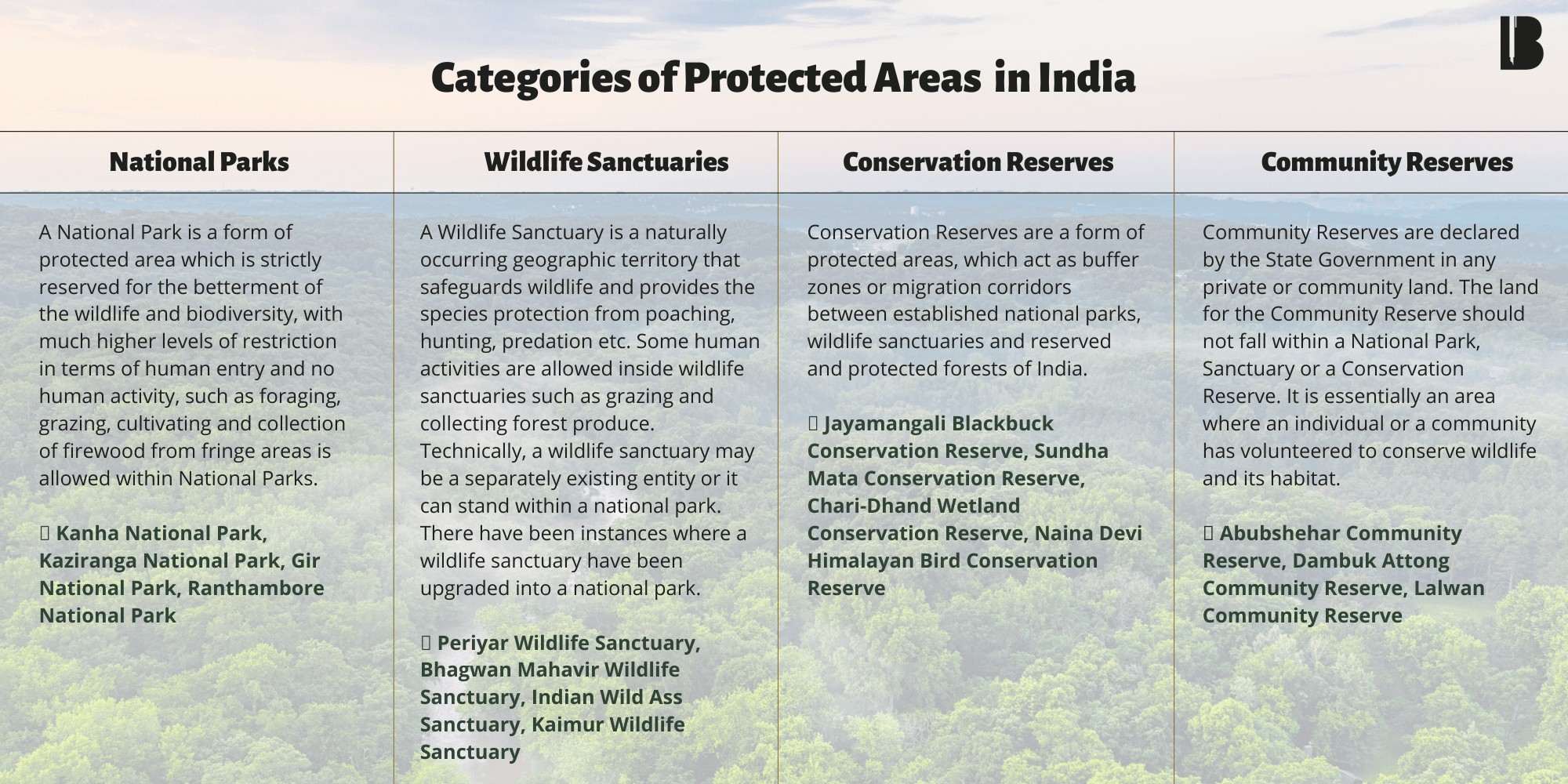
A recent report published by the Centre for Financial Accountability (CFA) draws attention to infrastructure and development projects in Protected Areas. Between 2015 and 2019, several environmental and wildlife clearances have been granted to projects that raise fundamental questions about the intended beneficiaries, socio environmental impacts, and available alternatives. The ongoing debate on development v/s conservation calls for assessing the growing impact of development projects in Protected Areas and ensuring they are financially accountable.
In a State of Flux: Infrastructure Projects and Protected Areas
Infrastructure is considered the backbone of any economy. The impetus on the infrastructure sector becomes much more in a growing economy, with the government terming investment in infrastructure “quintessential” to boost growth as highlighted in Economic Survey 2020-21. Government’s thrust on the infrastructure sector can also be assessed from flagship programs like the ambitious National Infrastructure Pipeline (NIP) announced in 2019, which would need a projected investment of ₹111 lakh crore for carrying out the infrastructure projects between 2020 and 2025. Similarly, this year in the budget, the government announced a total outlay of ₹7.5 lakh crore of capital expenditure (capex), a 35 per cent increase from the previous year, giving a major push to the infrastructure sector along with stressing on its multiplier effect.
Also Read: How India’s Private Infrastructure Projects Risk Economic Stability, Environment, and Public Welfare
The infrastructure projects which have come up across the country in the last few decades, along with extractive projects such as mining projects, have also encroached the forest lands and green cover—which have been under ever increasing threats due to the pressure to make way for such projects, even at the cost of biodiversity and environment. The impact of infrastructure projects and resource extraction projects also extends to affected the communities dependent on forests who have had a symbiotic relationship with the forests for centuries and who have also played a key role in protecting these forests. It is not only the forest areas that have been diverted for non-forestry purposes, but even the protected areas such as tiger reserves have come under threat due to the ‘inevitability’ of the infrastructure projects, which is often cited as the reason for giving a go ahead by the various ministries of governments, including the environment ministry.

The Debate on Development v/s Conservation
Indians are regularly privy to the larger debate on ‘Development v/s Conservation’ whenever there are controversial infrastructure or developmental projects coming up in forest areas, which causes diversion of forest land. These projects bring up some fundamental questions—how are these projects justified, who are the intended beneficiaries, what are environmental and social impacts, are there any available alternatives, and more. Often, the impetus for such projects come from a particular model of development which places high thrust on infrastructure-led economic growth and is highly dependent on resource extraction. This model of development often goes against the ethos of sustainable development as they tend to cause large-scale irreversible damage to the environment for the sake of financial returns and addressing the demands of a consumer-driven economy.
Diversion of forest lands for such projects cannot simply be replaced by shallow mitigation measures such as “tree plantations”, with forests having an inherent eco-system of their own which takes centuries to evolve.
However, when such infrastructure or developmental projects invade spaces like the protected areas, compared to other forest lands, the ‘Development vs Conservation’ goes to the next level. The protected areas were envisaged primarily with the purpose of preserving our precious biodiversity including several endangered species of plants and animals. The destruction of protected areas caused by such projects cannot be compensated by any financial means and deserves more public debate and scrutiny regarding the inevitability of such projects.
Setting up any industry or development project near or within protected areas requires Wildlife Clearance, along with the mandatory Environmental Clearance. Wildlife Clearance is a clearance or permission required from National Board for Wildlife (NBWL) as per Supreme Court order to establish any industry or development projects inside or within 10 km radius of any protected area. This additional protection had been envisaged considering the crucial role played by the Protected Areas in conservation efforts, along with preventing industrial or developmental projects from mushrooming in their immediate vicinity.
However, the NBWL has come under scanner for acting more like a facilitator for sanctioning various projects, than acting as a vigilant watchdog for safeguarding the protected areas. When the entire nation was under lockdown, on April 07, 2020, a virtual meeting was held by the Standing Committee of NBWL, where 31 proposals were discussed regarding projects inside or within 10 km of protected areas; out of them, a staggering 26 projects were approved. 16 of the approved projects were linear infrastructure projects such as highways, transmission lines and railway lines which cut through national parks, sanctuaries and tiger corridors.

Similarly, the other projects spread over 3,000 acres of land located in eco-sensitive areas were also approved. If one goes back slightly further, one can see that NBWL gave wildlife clearances to 680 projects between 2015 and 2020, according to an answer given in the Rajya Sabha by the Environment Ministry in September 2020. The Standing Committee of the NBWL met 23 times between 2015-16 and 2019-20 during which it granted clearance to these 680 projects.
The protection of forests and protected areas is largely contingent on how strong are the environmental laws which play a crucial role in safeguarding them. In order to make way for the industry, there have been constant attempts to weaken environmental laws; the Draft Environmental Impact Assessment (EIA) Notification, 2020 brought out by MoEFCC in April 2020 was a glaring example of this intent, replacing the EIA Notification, 2006. The Draft EIA Notification drew heavy criticism from environmentalists, scientists, activists and citizens due to some glaring loopholes such as post-facto clearances and reduced public participation.
Citizens and environmentalists are skeptical as the changes brought in the environmental laws often lead to irreversible damages, but the laws are being moulded in a manner which can facilitate in making businesses more profitable.
Also Read: Shrinking Negotiations: How the Draft EIA 2020 Is Affecting Public Consultations on Development
Concerns have also been raised regarding the displacement faced by forest-dwelling communities who had been pressured to vacate the Protected Areas as they were being seen as encroachers on the forest lands on which they have survived for centuries. According to a study published in October 2020, a total of 13,450 families were displaced between 1999 and 2020 from 26 Protected Areas spread across the country. This displacement primarily happened due to the government’s push for creating ‘inviolate spaces’ in the name of conservation of biodiversity and wildlife, where the forest-dwelling communities were seen as an obstruction to the proliferation of wildlife, overlooking the symbiotic relationship of centuries between forest dwelling communities and the forests and how they have played a crucial role in protecting wildlife as well as the forests.
At the same time, a slew of linear infrastructure projects such as railways, highways and irrigation projects have been allowed to be materialised in the Protected Areas in the name of development, paradoxically overlooking the principle of inviolate spaces. A Wildlife Conservation Trust of India report published in November 2018 analysed 1,697 project proposals for Central India and the Eastern Ghats landscape which were submitted to MOEFCC between August 2014 and the end of 2017 for diversion of forest land. Out of these, 399 proposals were for railways, highways, and irrigation projects – which were likely to have a negative impact on the tiger corridors – bearing a total cost of approximately ₹1,30,000 crore.
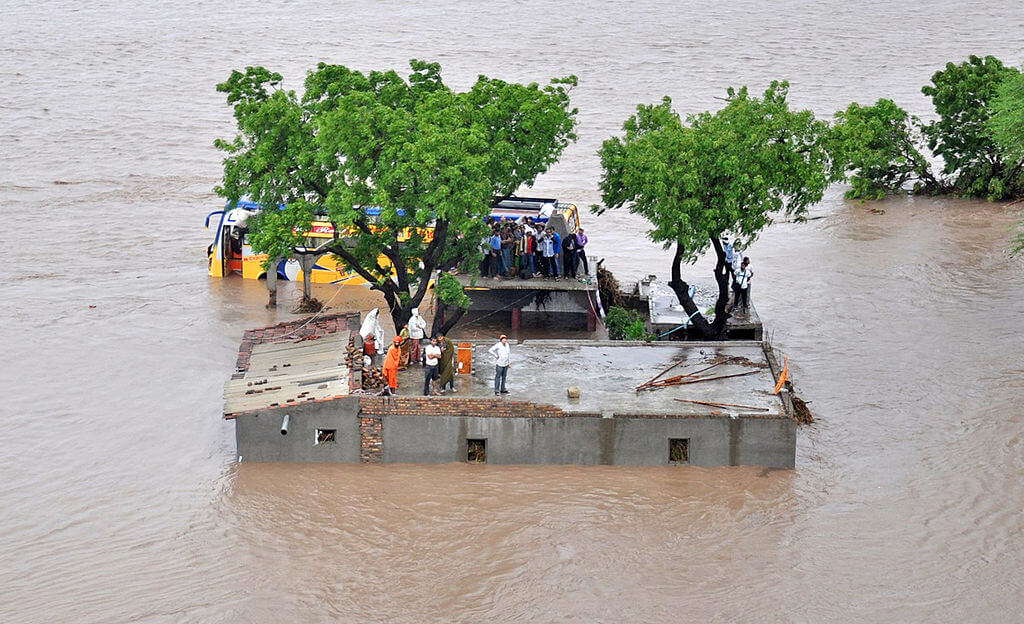
Such data implies that principles of inviolate spaces are side-lined when it comes to giving leeway to infrastructure projects. Moreover, various state governments have been encouraging wildlife tourism as a means to generate revenue through these Protected Areas, which also does not fall in line with the push for inviolate spaces.
Understanding the Growing Impact of Development Projects on Protected Areas
The Mapping Report by Centre for Financial Accountability (CFA) highlights data not just about the projects which had been given environmental clearances between 2015 and 2019, but also the projects which had applied for Wildlife Clearances. This gives a better idea as to what extent Protected Areas are being targeted for implementing a spectrum of projects. If one goes by the available data, out of the 2,592 proposals the MOEFCC received for environment clearance between July 2014 and April 24, 2020, it had approved 2,256 proposals, which comes to a clearance rate of 87 per cent. It should also be noted that out of these proposals, 270 projects have been in and around biodiversity hotspots and national parks. Such a rate of approval, along with dilution of environmental laws raises further concerns.
Often, the infrastructure or developmental projects within or near the Protected Areas are analysed on a one-to-one basis to understand their impacts. The clearances given to these projects, whether environmental clearance, forest clearance, or wildlife clearance, mainly take into consideration the impact of the specific project per se while granting the clearances. However, when it comes to the impacts at the ground level, any such Protected Area would have to face the cumulative impact of multiple projects in a designated area. This reality is often overlooked by authorities, especially while granting necessary clearances.
At times, a given Protected Area might have to face the brunt of multiple linear infrastructure projects such as railways, highways, irrigation, and transmission lines which need to be analysed together. Similarly, some developmental projects may drive the need for other infrastructure projects. For example, a coal mining project near a protected area cannot happen in isolation. This would require development of a road or a railway line to enable transportation of coal, labour, etc. There may be a necessity for more transmission lines to be laid out to transmit electricity for running machinery, and so on.
Also Read: The Impacts of Unsustainable Iron Ore Mining on Redi, The Last Village on Maharashtra’s Konkan Coast
According to Parivesh portal, between the years 2015 and 2019, a total of 3,622 applications had been submitted for granting wildlife clearances of projects within or near Protected Areas. Out of these, 185 projects had a project area of more than 10 hectares of land. Further analysis showed that 123 of these projects fell within the boundary of the protected areas and 62 projects were located in the buffer zone. The pie chart below shows the category-wise distribution of development projects which had applied for wildlife clearances.
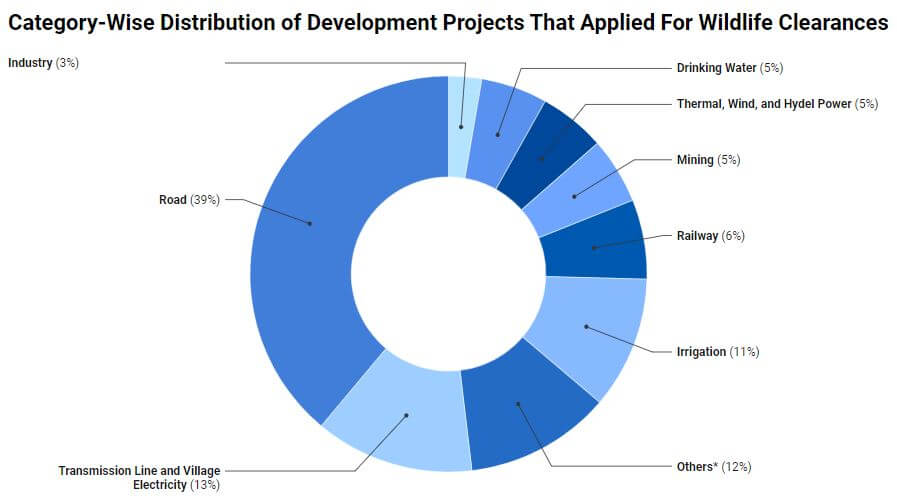
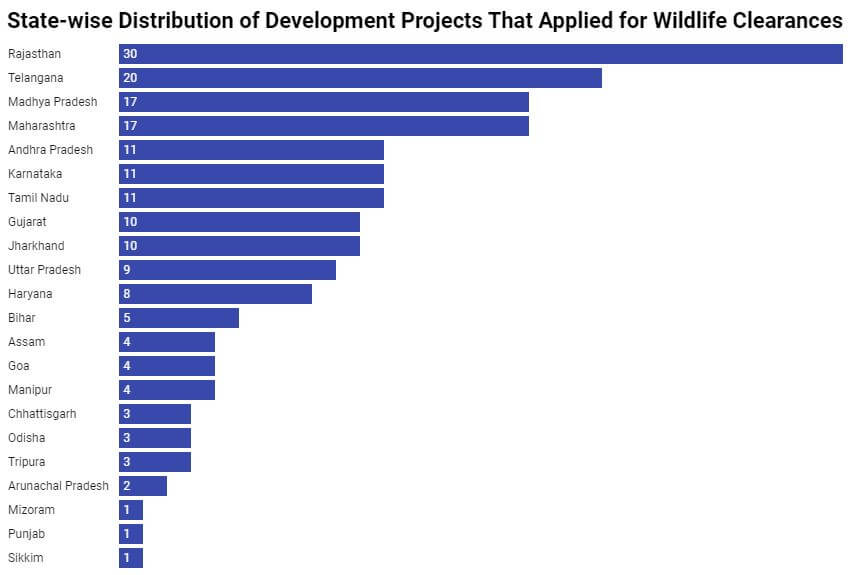
Need of the Hour: Financial Accountability to Save Protected Areas
Finance plays a key role as an enabler for any infrastructure or developmental project. Often the project proponents raise money through banks and other financial institutions for such projects rather than simply reinvesting their profits. This is where banks and other financial institutions come into the picture. Some specific infrastructure projects such as railways and highways rely heavily on budgetary allocations along with raising money through other sources. If there is transparency around the financing of these projects, then such information can be used as a strategic tool by various civil society and environmental organisations in holding the financiers accountable for financing the projects which cause irreversible damage to protected areas.
Due to the lack of information in the public domain, CFA’s Mapping Report does not focus on the finances behind the projects which are being implemented within or near the protected areas. Many of these projects are being implemented by private companies who do not disclose any financial data regarding their projects. There is also a lack of information on who these financiers are, including banks. In exceptional cases, if there are any projects which have its funding from International Financial Institutions (IFIs) such as World Bank and ADB, some information is usually available, as these IFIs have better disclosure policies regarding their funding of projects. However, in the case of National Financial Institutions (NFIs), this information almost becomes like a black box.
There is also a lack of clear Environmental and Social Safeguard (ESG) policies among financial institutions in the country, especially with regards to forests and protected areas which needs to be addressed to make the financial institutions more accountable on a proactive basis, rather than leaving it to affected communities or activists to raise concerns and grievances. There is also a need for more transparency for any project being implemented within or near Protected Areas; disclosing its financial details in the public domain will allow greater public scrutiny, enabling immediately concerned citizens and CSOs to intervene.
Checks and Balances: The Way Out
No matter how much attention is brought to the value of preserving Protected Areas, any efforts in this direction would be considered to be truly successful only when the larger debate around our development tropes is addressed. Since the current model of GDP-led economic growth puts natural habitats at peril, ruling governments often align with the needs of industry and enterprise, disregarding their role of protecting nature. The encroachment of linear infrastructure projects and developmental projects in Protected Areas needs to be kept in check, without which the situation would turn for the worse in the years to come as the pressure of diversion of forest land will keep piling up at the times when we are already witnessing the disastrous impacts of climate change across the globe.
There is a need for the authorities to introduce a mechanism of assessing the cumulative impacts of the projects within or near a protected area. Such a mechanism should account for all the projects of the past, as viewing some of these proposals on a standalone basis may not appear threatening by itself. Put together, they could exacerbate the situation around a Protected Area irreparably. The way projects are weighed also needs a relook.
The argument that a project is ‘inevitable’ falls short because very often, only an anthropocentric approach is used to analyse such proposals in terms of their benefits. This, instead of adopting an ‘ecocentric‘ approach to evaluating project proposals – one that recognizes the intrinsic value of all living beings, giving importance to all species of flora and fauna, especially those who are endangered, irrespective of the fact whether they are instrumental for human survival or not.
Holding financial institutions accountable for financing projects in and around Protected Areas can evolve as an important tool for ensuring that environmentally destructive projects are not financed. Realising this would be contingent on ensuring that financial information related to such projects is brought out in the public domain on a proactive basis. Yet, the question as to how far down the road this realisation lies remains unanswered, with many smaller pieces needing to fit into the puzzle first. At the end of the day, India’s Protected Areas are too precious to make way for growth-led economies; it is time for citizens, industrialists, financers, and the government to come together in ensuring that Protected Areas are preserved for generations to come.
Featured image is of a four lane highway network between Hassan and Bengaluru in Karnataka. Courtesy: Sarah Welch via Wikimedia Commons


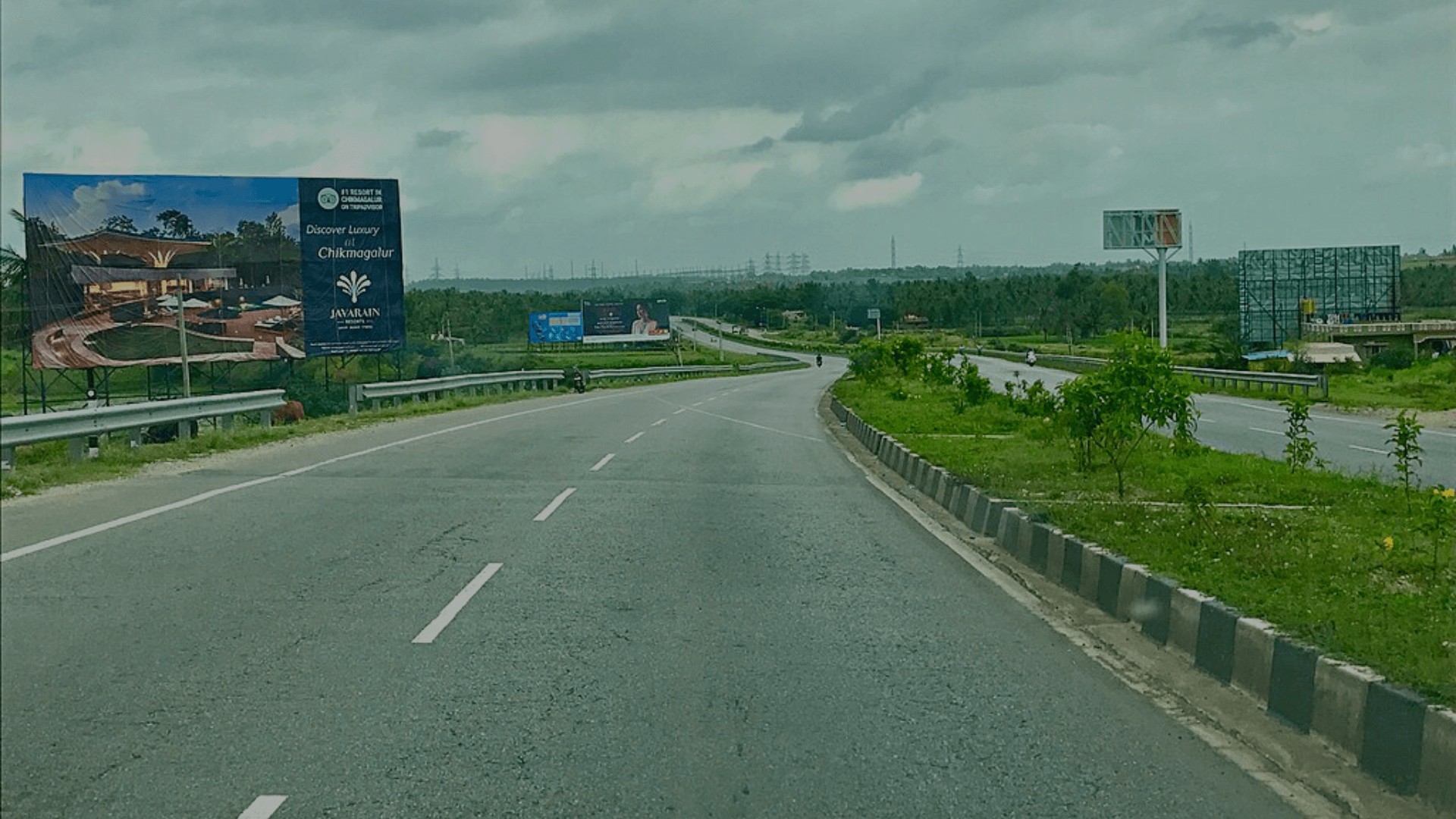


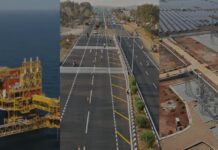

awesome